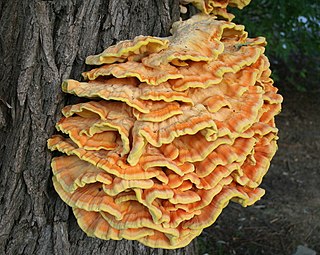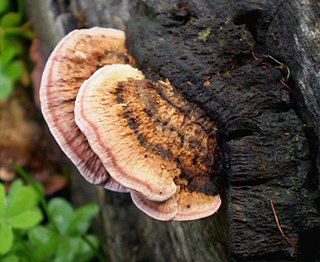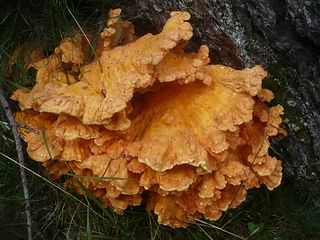
The Polyporales are an order of about 1800 species of fungi in the division Basidiomycota. The order includes some polypores as well as many corticioid fungi and a few agarics. Many species within the order are saprotrophic, most of them wood-rotters. Some genera, such as Ganoderma and Fomes, contain species that attack living tissues and then continue to degrade the wood of their dead hosts. Those of economic importance include several important pathogens of trees and a few species that cause damage by rotting structural timber. Some of the Polyporales are commercially cultivated and marketed for use as food items or in traditional Chinese medicine.

Laetiporus is a genus of edible mushrooms found throughout much of the world. Some species, especially Laetiporus sulphureus, are commonly known as sulphur shelf, chicken of the woods, the chicken mushroom, or the chicken fungus because it is often described as tasting like and having a texture similar to that of chicken meat.

Laetiporus sulphureus is a species of bracket fungus found in Europe and North America. Its common names are crab-of-the-woods, sulphur polypore, sulphur shelf, and chicken-of-the-woods. Its fruit bodies grow as striking golden-yellow shelf-like structures on tree trunks and branches. Old fruitbodies fade to pale beige or pale grey. The undersurface of the fruit body is made up of tubelike pores rather than gills.

The Fomitopsidaceae are a family of fungi in the order Polyporales. Most species are parasitic on woody plants, and tend to cause brown rots. The name comes from Fomitopsis + -aceae.

Fomitopsis is a genus of more than 40 species of bracket fungi in the family Fomitopsidaceae.

Fomitiporia is a genus of fungi in the family Hymenochaetaceae. According to a 2008 estimate, the widely distributed genus contains 11 species, though three new species were identified in 2010 in sub-Saharan Africa using multigene molecular phylogenetic analysis, and two more were named in a 2013 article. In 2011 it was announced that a specimen of the species F. ellipsoidea was discovered with a fruit body that is largest known of any fungus. However, the species has since been moved to Phellinus.

Rubroboletus rhodoxanthus is a species of bolete in the family Boletaceae, native to Europe. Previously known as Boletus rhodoxanthus, it was transferred in 2014 to the newly erected genus Rubroboletus, based on DNA data.

Rhodofomitopsis lilacinogilva is a species of bracket fungus in the family Fomitopsidaceae. Known primarily from Australia, it has also been recorded from Brazil and India. It is a white-rot fungus that grows on rotting eucalyptus wood. Its main identifying feature is the lilac colour of the pore surface on the underside of the fruit body.
Laetiporus ailaoshanensis is a species of polypore fungus in the family Fomitopsidaceae. It is found in southwestern China, where it grows on Lithocarpus. The species was described as new to science in 2014 by Baokai Cui and Jie Song. Its fruit body has an orange-yellow to reddish-orange cap surface, with cream to buff pores on the cap underside. The fungus produces ovoid to ellipsoid basidiospores that measure 5.0–6.2 by 4.0–5.0 μm. Molecular analysis of internal transcribed spacer DNA sequences indicate that L. ailaoshanensis is a unique lineage in the genus Laetiporus.

Laetiporus conifericola is a species of polypore fungus in the family Fomitopsidaceae. It is found in western North America ranging from California to Alaska, where it grows as a plant pathogen on conifer trees, particularly fir, spruce, and hemlock. Fruit bodies of the fungus comprise overlapping pore-bearing plates, measuring collectively up to 60 cm (24 in) across, and up to 4 cm (2 in) thick. Their color ranges from bright orange to salmon orange on the upper surface of the cap and stipe, with a yellow pore surface on the cap underside. Spores are egg-shaped, smooth, hyaline (translucent), and measure 6.5–8.0 by 4.0–5.0 μm. The species has a pleasant odour when fresh.
Laetiporus cremeiporus is a species of polypore fungus in the family Fomitopsidaceae. It is found in cooler temperate areas of China and Japan, where it grows on logs and stumps of hardwood trees, especially oak. The fruit body of the fungus comprises large masses of overlapping reddish-orange caps with a cream-colored pore surface on the underside.

Laetiporus montanus is a species of polypore fungus in the family Fomitopsidaceae. It is found in mountainous areas of central Europe and in China, where it grows on conifers.
Fibroporia albicans is a species of poroid crust fungus in the family Fomitopsidaceae. It causes a brown rot. The fungus was described in 2015 as a species new to science, based on collections made in Jiangxi and Xizang Provinces, China. It is one of five Fibroporia species recorded in China.
Fragiliporia is the sole genus in the fungus family Fragiliporiaceae. It contains the poroid crust fungus Fragiliporia fragilis, described as new to science by Chinese mycologists in 2014. The type specimen of this fungus was discovered growing on a rotting stump of alder in the Gaoligongshan National Nature Reserve in Yunnan. The specific epithet fragilis refers to the brittle fruit bodies of the fungus. Molecular phylogenetics shows that the fungus is in an isolated position in the Polyporales, distinct from the six previously identified clades in this order. In a later study (2017), Fragiliporia was recovered in a phylogenetically isolated position as sister to Candelabrochaete africana.
Fomitopsis subfeei is a species of polypore fungus in the family Fomitopsidaceae. Found in southern China, it was reported as new to science in 2014 by mycologists Mei-Ling Han and Bao-Kai Cui. Characteristics of the fungus include perennial, effused-reflexed to pileate fruit bodies, a concentrically grooved cap surface, and a pinkish-brown to vinaceous-brown pore surface on the cap underside. Microscopic characters include spindle-shaped cystidioles, and small, oblong-ellipsoid spores measuring 4–5 by 1.9–2.5 μm. The fungus causes a brown rot on gymnosperms.
Amanita subpallidorosea is a mushroom of the large genus Amanita, which occurs under oaks in southern China and Taiwan.
Postia duplicata is a species of poroid fungus in the family Fomitopsidaceae that was described as a new species in 2014. It is found in Yunnan and Zhejiang provinces of China, where it causes a brown rot on angiosperm wood. The fungus is named (duplicata) for its characteristic two-layered context, a feature that distinguishes it from other Postia species. The spores made by this fungus are cylindrical, hyaline, smooth, and typically measure 3.8–5.8 by 1.8–2.5 µm.
Datroniella tropica is a species of crust fungus in the family Polyporaceae. Found in southwestern China, it was described as a new species in 2014 by mycologists Bao-Kai Cui, Hai J. Lee, and Yu-Cheng Dai, who placed it in the new genus Datroniella. The type collection was made in Tongbiguan Nature Reserve, where the fungus was found growing on a fallen angiosperm branch. The specific epithet tropica refers to its distribution in tropical China.
Ungulidaedalea is a fungal genus in the family Fomitopsidaceae. The genus was circumscribed by Chinese mycologists in 2016 to contain the single species Ungulidaedalea fragilis, a fungus that was described as new in 2014 with the name Fomitopsis fragilis. The holotype of this fungus was collected in Jianfengling Nature Reserve, in Ledong County (Hainan). The generic name Ungulidaedalea refers to the resemblance between this species and Daedalea, and also to the hoof-shaped (ungulate) form of the fruit body. Ungulidaedalea fragilis has rather fragile fruit bodies with a dark brown crust and large angular pores on the cap underside. Microscopic characteristics include its densely septated skeletal hyphae, and oblong-ellipsoid spores that measure 4–5.2 by 2.2–2.8 μm.

Cerrena zonata is a species of poroid fungus in the genus Cerrena.









